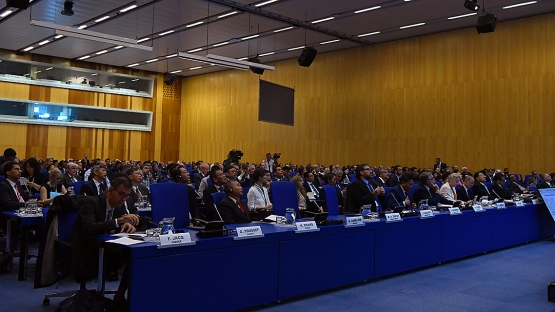As global carbon dioxide (CO2) emissions continue to rise despite increasing use of renewables, the nuclear power industry is looking to lessons from its past success as well as innovations on the horizon in a bid to cut construction times and costs and accelerate the global transition to low carbon energy.
But the full value of nuclear power—the only energy source along with hydropower that has demonstrated the capability to decarbonize electricity supply on a national scale—needs to be fully recognized if the world is to solve its climate conundrum.
These were some of the key messages from the International Conference on Climate Change and the Role of Nuclear Power. The weeklong event, which concluded in Vienna today, was organized by the IAEA in cooperation with the Nuclear Energy Agency (NEA) of the Organisation for Economic Cooperation and Development (OECD).
“The main message of the conference is this: To meet the climate goals which the nations of the world have agreed on, we need to be much more ambitious,” IAEA Acting Director General Cornel Feruta said in his closing remarks to the conference.
The costs of nuclear?
A handful of newbuild nuclear projects in Europe and the United States have suffered high profile construction delays and cost overruns, prompting criticism that low carbon nuclear power will struggle to help fight climate change. Yet in many countries, new nuclear power projects are being delivered mostly on time and on budget, including in Belarus, China, Korea and Russia.
Their success echoes the experience of nuclear power construction in decades past, when its rapid deployment largely decarbonized electricity production in countries like France and Sweden, speakers at the conference said.
“The vast majority of newbuild projects around the world are delivering very low cost, successful nuclear programmes, achieved through repeat builds, a programmatic approach, and building up skills and capabilities within the supply chain, labour force and project leadership team,” said Kirsten Gogan, co-founder and Executive Director of Energy for Humanity, a non-profit focused on solving climate change via access to modern energy services. “That’s actually what will drive down the cost.”
According to data compiled by the IAEA on the 61 new power reactors connected to the grid over the last decade, units in the Far East were built almost twice as quickly as those in Europe, taking on average 66 months versus 110 months.
So why have some newbuilds gone over budget and schedule?
“What they have in common is that they are all first-of-a-kind, first-in-a-generation projects,” Gogan said. “There isn’t the experience within the project leadership teams, supply chain or labour force, and those designs are being licenced for the first time by regulators that haven’t really gained real life experience of licencing plants for a generation.”
Jessica Lovering, a former Director of Energy at the Breakthrough Institute, a U.S.-based non-profit organization, said the key to bringing down construction costs and times is to achieve high learning rates by repeating projects using standardized designs. “If you look at South Korea today, their costs and construction times have been coming down gradually, so they can get a plant built in three to four years,” Lovering said. “For a plant that’s over a gigawatt, that is really fast in terms of adding electricity to the grid.”
The industry needs to move away from being largely focused on massive one-off projects, she said. “We have to move from project to product,” Lovering said, adding that the deployment of small, medium sized or modular reactors (SMRs) will shift the industry’s approach.
SMRs, which will be partly built in factories, “will get costs down and turn nuclear power deployment into a normal industry where you move from projects where each one is different to a product approach,” said Tony Roulstone of Cambridge University in the United Kingdom.
Nuclear power is a baseload source that reliably provides electricity around the clock, day and night, regardless of weather conditions. In systems with increasing and high shares of variable renewables, nuclear may be called on to provide back up when variable renewables are not producing and balance the grid in the absence of other power generation.
Establishing the ability of nuclear plants to ramp up and down for load following will affect their economics, according to a 2018 IAEA study Non-baseload Operation in Nuclear Power Plants. While the use of nuclear as a back-up adds value to the power system, in almost all countries today dispatchable generators like nuclear are not appropriately compensated for providing such a service.
Moreover, for many financial institutions today, nuclear power does not qualify for financing under green or sustainable financing mechanisms. In addition, many markets do not price CO2 emissions, to the detriment of low carbon nuclear. Unless this changes, the economics of deploying new reactors in deregulated markets will remain challenging, speakers said.
To meet climate objectives under the Paris Agreement, the CO2 footprint of a country’s electricity production must fall to 50g CO2 per kWh or even lower.
“In 2015, France met that objective,” said William D. Magwood, IV, Director-General of the NEA. However, he noted that in many other member countries of the OECD, the CO2 footprint remains more than 10 times higher than in France, where nuclear power provides almost three quarters of electricity generation – more than in any other country.
“If you want to solve a problem, then you should find someone who has already solved the same problem,” said Staffan Qvist, an engineer and co-author of A Bright Future: How Some Countries Have Solved Climate Change and the Rest Can Follow. “Fortunately, we know what the world has already done on this topic.”





